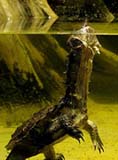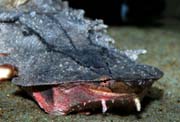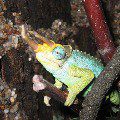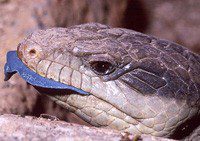
Matamata (fringed turtle)
Matamata (Chelys firnbriata), the only species of the genus of fringed turtles of the serpentine family. Lives in Venezuela, Guyana, Brazil. The dorsal shield is up to 40 cm long, oval in shape, with three longitudinal rows of large tubercles. The ventral shield is long and narrow. The head is triangular, the nose is in the form of a trunk – Matamata exposes it to the surface when it burrows into the silt at the bottom of the reservoir. The mouth is very wide. The skin of the head and neck from the sides with fringed outgrowths that camouflage the turtle among aquatic vegetation. Feeds on fish and invertebrates. Peak activity occurs at dusk.
Contents
Other names
Fringed turtle. Chelus fimbriata.
Classification
Kingdom: Animals
Type: Chord
Subtype: Vertebrates
Class: Reptiles
Order: Turtles
Suborder: Side-necked turtles
Family: Serpent-necked turtles
Genus: Fringed turtles
Species: Fringed Tortoise, Matamata
Inhabitation
 Matamata, like some other turtles with an unusual appearance (for example, caiman), is distributed mainly in the warm climate of the South American mainland, in particular, in its central and northern territories. Among the reservoirs in which it can be found is the Orinoco River basin. And the habitat of the fringed turtle extends to the Amazon basin. Among the countries where matamata is found, mainly the states of South America, such as Venezuela, Colombia, Ecuador, Peru, Bolivia, Guiana, Guyana, Suriname, central and northern parts of Brazil. Matamata does not like fast flowing rivers. She likes slow-flowing reservoirs with a muddy bottom and stagnant water: old riverbeds, swamps, silted ponds. But the matamata does not climb into deep places; rather, it can be found on mudflats or in shallow water. Silt or clay at the bottom of reservoirs is a quite characteristic biotope for it. Such a love of silt can be explained by the fact that all freshwater turtles, including matamata, find peace on a soft bottom during hibernation, the ability to become invisible while hunting, and also a refuge from danger. And one more feature of the matamata habitat: it mainly inhabits reservoirs with the so-called black water, that is, saturated with decay products of various organic matter – plant and animal remains. The pH balance in such water is noticeably lowered towards the acid side.
Matamata, like some other turtles with an unusual appearance (for example, caiman), is distributed mainly in the warm climate of the South American mainland, in particular, in its central and northern territories. Among the reservoirs in which it can be found is the Orinoco River basin. And the habitat of the fringed turtle extends to the Amazon basin. Among the countries where matamata is found, mainly the states of South America, such as Venezuela, Colombia, Ecuador, Peru, Bolivia, Guiana, Guyana, Suriname, central and northern parts of Brazil. Matamata does not like fast flowing rivers. She likes slow-flowing reservoirs with a muddy bottom and stagnant water: old riverbeds, swamps, silted ponds. But the matamata does not climb into deep places; rather, it can be found on mudflats or in shallow water. Silt or clay at the bottom of reservoirs is a quite characteristic biotope for it. Such a love of silt can be explained by the fact that all freshwater turtles, including matamata, find peace on a soft bottom during hibernation, the ability to become invisible while hunting, and also a refuge from danger. And one more feature of the matamata habitat: it mainly inhabits reservoirs with the so-called black water, that is, saturated with decay products of various organic matter – plant and animal remains. The pH balance in such water is noticeably lowered towards the acid side.
Description
The amazing external qualities of the matamata were already mentioned at the beginning of the article. It’s time to describe them in more detail. As can be seen from the classification, the names of the suborder and the matamata family – side-necked and snake-necked turtles – are also not accidental. Matamata belongs to side-necked turtles because of the structure of its skeleton. The neck of this reptile, when it draws its head under the shell, does not bend vertically, but, as it were, wraps itself. As a result, the turtle’s head touches the base of its front paw. Snake-necked turtles like matamata are named because of the same rather long and bizarrely curving neck. But this is not all the amazing features of matamata. She has a kind of carpax – the upper shield of the shell. It is divided into three parts by jagged keels, which are formed from sharp cones protruding from each plate of the carp. Matamata is a fairly large reptile. Its carapace is approximately 40 cm. The dorsal part, the same carpax, is dark brown in color. It is thanks to him that the matamata disguises itself as a snag at the bottom of the reservoir. And the long and narrow plastron – the abdominal part – is noticeably lighter. But its color is also dominated by water shades – greenish-yellow or brown. The tail of the matamata, like its entire body, is protected by a strong clawed case that distinguishes the reptile from other types of turtles. Well, the head and neck deserve a separate discussion.
As already mentioned, the matamata’s neck is extremely long, which is not typical for other turtles. Scalloped leathery patches hang from it and from the head of the animal. The head of the matamata is slightly flattened, has the shape of a triangle and ends in a sharp proboscis, the same thing that usually sticks out of the silt. The eyes of the turtle seem to be pushed forward, and the huge mouth reaches the very ears and opens very wide, because the matamata does not know how to chew or bite food – it swallows it whole. The voracity of the turtle is simply fantastic. When she begins to swallow fish, she fills her stomach and even her neck completely, where food waits for its turn to be digested.
Matamata is a nocturnal animal. During the day, she hides in the mud, and at night she goes hunting. Most of the time the turtle spends in the water, and on land it can only be seen during breeding. In zoology, matamata continue to be one of the most mysterious objects. Not much is known about their behavior. For example, scientists do not fully understand whether the matamata needs light, because most of the time she hides from him. And the features of its reproduction, even in the specialized literature, are described rather superficially.
Food
Love for live fish and an unusual way of hunting secured the fame of a real predator for the matamata. Its main diet is animal food – fish, tadpoles, amphibian larvae and small invertebrates. Aquatic vegetation is a rare guest in the stomach of a matamata. And in artificial conditions, it is quite difficult to deceive a matamata by feeding it with dead fish. You can try to gradually accustom the turtle to such food, carefully moving pieces of the product in front of it. However, this does not guarantee that the matamata will eat. Perhaps one of the reasons for this pickiness is the lack of the right amount of vitamin B in dead, especially thawed fish. So, if the matamata is kept in captivity, it should be added to the turtle’s diet. For young members of the genus Fimbriata, live fish food, such as worms and bloodworms, may be suitable food. Adult matamata can be given aquatic insect larvae or fed whole creatures. Also, these turtles are able to recognize fish by the sheen of scales and will never confuse it with a foreign shiny object. But if you still manage to accustom her to another food, then over time your matamata will eat all the food offered, whether it be pieces of fish, chicken or even small mice. Zoologists do not recommend giving large food to the matamata due to the inability to grind it.
Reproduction
 All year round matamata is capable of reproducing its own kind. Mating games in these turtles occur mainly at night. And the male and female never show aggression towards each other. It is possible to distinguish heterosexual fringed turtles from each other by external signs: the male has a longer tail and a concave plastron. Matamata, like other turtles, are oviparous. After mating, they lay about 10-30 eggs. Interestingly, the heat-loving matamata lays masonry in the winter, from October to December. The time until the offspring exits the eggs depends on the ambient temperature. If it is above 30 degrees, which is typical for some latitudes of the matamata habitat, then the cubs appear after 2-4 months. And if the temperature does not exceed 5 degrees, then the offspring should be expected no earlier than in 25-8 months.
All year round matamata is capable of reproducing its own kind. Mating games in these turtles occur mainly at night. And the male and female never show aggression towards each other. It is possible to distinguish heterosexual fringed turtles from each other by external signs: the male has a longer tail and a concave plastron. Matamata, like other turtles, are oviparous. After mating, they lay about 10-30 eggs. Interestingly, the heat-loving matamata lays masonry in the winter, from October to December. The time until the offspring exits the eggs depends on the ambient temperature. If it is above 30 degrees, which is typical for some latitudes of the matamata habitat, then the cubs appear after 2-4 months. And if the temperature does not exceed 5 degrees, then the offspring should be expected no earlier than in 25-8 months.
In captivity, matamata rarely breeds, but if you really want to get cubs from her, then you should prepare a suitable substrate for masonry – acidic water, peat or vermiculite. If the acid-base balance of water is neutral, then the embryos can simply die in the last stages of their development, despite the fact that they develop for a long time. In contrast to the caiman turtle, the dependence of the sex of the offspring of the fringed turtle on the ambient temperature has not been studied. Newborn matamata are about 4 centimeters in size, and when they begin to grow, suitable conditions should be prepared for them, since young fringed turtles swim poorly and can simply drown in a deep aquarium. In general, all matamats prefer to stick their nostrils out of the water to ensure normal breathing.
Content
This amazing turtle is often found in terrarium collections. Matamata easily adapts to life in artificial conditions. But in order to provide her with a comfortable existence, a truly spacious aquarium is needed. Do not forget about the thermophilicity of matamat, so that the water temperature should be kept at about 28-30 degrees, as well as the ambient air temperature. Since the matamata prefers to hide in the mud during the day, it should also have a shelter from sunlight in the aquarium. To do this, you can build some kind of shelter where the turtle can fit entirely. It is better to pour clean sand at the bottom of the aquarium, and swamp vegetation, various underwater roots or cork material are suitable to simulate the coast. The main thing is not to make the aquarium too deep. The depth of the water in it should not exceed 20 cm – it is necessary that the tortoise shell can only hide under it. Once a week, it is necessary to measure the PH-balance of the aquatic environment in the home of the matamata, and if its norms exceed the permissible ones (5, 0-5, 5), then special preparations sold in pet stores can be used to normalize. Peat also contributes to the acidification of water. Add boiled peat crumbs to the aquarium filter, and your fringed pet will be healthy. Perhaps the requirements for the aquatic environment can cause the greatest difficulties in caring for a matamata. Otherwise, this is a fairly unpretentious creature. She swims not very well even in adulthood, while she is lazy and prefers to lie in wait for her prey. And even to get air, the matamata makes a minimum of movements, just lifting the very tip of its proboscis out of the water. Yes, and this turtle moves slowly, preferring to crawl along the bottom.
Additionally
Matamata is a reptile, highly unusual. What is worth one only its appearance. This turtle belongs to the genus Fringed and is so named because its head and neck seem to be hung with pieces of skin resembling flaps or fringes. Thus, it disguises itself, hiding at the bottom of reservoirs, where, frozen, it becomes like a stone overgrown with moss or a piece of a tree trunk with bark. And with its unusual appearance, the matamata attracts a victim, enchanted by the vibration of these skin flaps in the water. However, sinking to the bottom and burrowing into the silt, the matamata still exposes its long, trunk-like nose to the surface. Not only the appearance of this turtle is amazing, but also other qualities that nature has endowed it with. She knows how to open her mouth so wide during the hunt that she usually swallows her prey whole, along with water, which then exits back through a slightly open mouth. In addition, the matamata is able to distinguish the state of its prey. If she accidentally swallowed a dead fish, she will immediately spit it out. Most likely, there are some special receptors in the turtle’s stomach, thanks to which it receives information about food.
Despite their natural laziness and long hours of immobility during the hunt, zoologists have noted cases when the matamata pounced from the water on small birds flying past. True, the turtle prefers to hunt at night. She has sharp, dark-adapted vision. Some matamat owners have noted that their pets’ eyes glow in the dark, like those of cats and alligators.
Sources of
http://ru.wikipedia.org
http://www.floranimal.ru/
http://slovari.yandex.ru
http://www.zoopicture.ru/
http://www.cherepahi.ru/
http://zverushki.tomsk.ru/
http://school316.spb.ru
http://zoovet.in.ua
http://www.i-nature.ru
http://www.zooclub.ru





